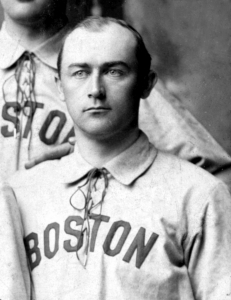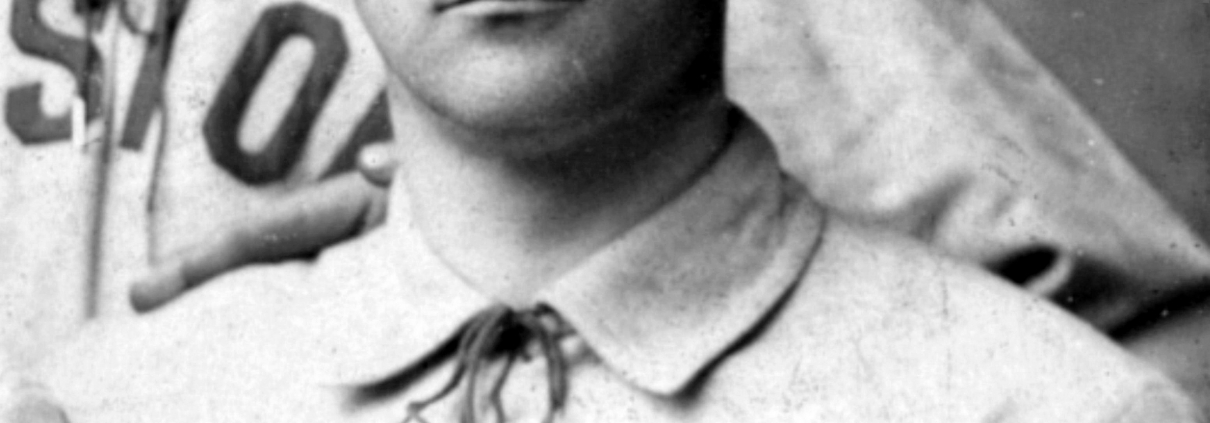August 16, 1895: Browns’ Tommy Dowd hits for the cycle in ‘somnolent game’
 The National League’s St. Louis Browns and Louisville Colonels faced each other on August 16, 1895, in what one newspaper described as “a somnolent game.”1 Even though the home team won and there were 13 total runs scored, the St. Louis Post-Dispatch told its readers that the two teams “put up a sleepy game,”2 while the St. Louis Globe-Democrat printed that “three hundred persons took advantage of the return of the St. Louis Base-ball Club to enjoy a siesta of two and a half hours”3 at Robison Field.4
The National League’s St. Louis Browns and Louisville Colonels faced each other on August 16, 1895, in what one newspaper described as “a somnolent game.”1 Even though the home team won and there were 13 total runs scored, the St. Louis Post-Dispatch told its readers that the two teams “put up a sleepy game,”2 while the St. Louis Globe-Democrat printed that “three hundred persons took advantage of the return of the St. Louis Base-ball Club to enjoy a siesta of two and a half hours”3 at Robison Field.4
Both St. Louis and Louisville had already lost all hope of winning the pennant in the 12-club NL, each being more than 30 games behind the front-running Cleveland Spiders. Both clubs had struggled ever since their original league, the American Association, merged with the NL after the 1891 season, bringing four AA teams to the NL.
The Browns, who had won the AA pennant every year from 1885 through 1888 and finished either second or third in the next three seasons, were consistently at the bottom of the NL standings. There were five different managers in 1892, when St. Louis finished 11th. Bill Watkins was the skipper in 1893, leading them to a 10th-place final landing, and in 1894, player-manager Doggie Miller steered them to ninth place.
The Browns had four managers in 1895: Al Buckenberger, owner Chris Von der Ahe (for one game), player-manager Joe Quinn, and Lou Phelan.5 Phelan took over on August 10 and had been in the position for about a week when the Browns hosted the Colonels. According to The Sporting News, Phelan was “a St. Louis saloon-keeper [who] knows less about the national game than Von der Ahe, and that is what Chris wants.”6
Across the diamond were the Colonels. Like St. Louis, Louisville had fielded a team in the American Association from 1882 through 1891, capturing the pennant in 1890. (The Browns were third that season.) They also joined the NL in 1892 but never finished better than ninth place. Bald Billy Barnie had managed the team in 1893-1894 but was replaced by Louisville native John McCloskey for the 1895 campaign. It was McCloskey’s first year as a manager in the major leagues, but he had several years of minor-league managing experience.
The 28-66-2 Browns were returning from a 15-game road trip to host a three-game series against the Colonels. They had lost 13 of the 15 contests, including a three-game sweep by Louisville, and tied one; their only victory was a 7-4 win over Pittsburgh on August 5. At the conclusion of this series, it was back on the road for 20 more games away from St. Louis.
Similarly, the Colonels had started a road trip on August 4. They played nine games before coming to St. Louis, losing seven of them, which gave them a 22-66-1 record. After the series with the Browns, the Louisville team was scheduled to stay on the road for another 25 games. This meant that they would not play in Louisville from August 4 until September 10.7
The Browns were led offensively by Tommy Dowd. Primarily an outfielder,8 Dowd began his major-league career with the AA’s Boston Reds in 1891 and had played for St. Louis since 1893. He was better known for speed and contact than power, stealing 368 bases and hitting 88 triples in 10 major-league seasons while managing only 24 career home runs and a modest lifetime slugging percentage of .345. In this game, however, Dowd’s four-hit day included three extra-base hits, as he hit for the cycle.
St. Louis native Theodore Breitenstein started the game for the Browns. After posting a National League-best 3.18 ERA in 1893, the first season when the distance from the rubber to home plate was increased from 50 feet to 60 feet 6 inches, left-hander Breitenstein’s mark jumped to 4.79 in 1894. In that season he led the NL in starts (50), complete games (46), and innings pitched (447⅓), while also allowing the most hits (497), runs (320), and earned runs (238). In 1895 he was not faring much better. Although he won 49 percent of the Browns’ games, he also suffered a league-high 30 losses. He was the “ace on a weak team.”9
Opposing Breitenstein on the mound was another left-hander, Louisville’s Bert Inks. Inks had joined the Colonels on August 31, 1894, in a trade with the Baltimore Orioles. In 1895 he made 27 starts, but his 6.40 earned-run average contributed greatly to his 20 losses.
The Colonels tallied twice in the first inning. John O’Brien led off with a triple down the left-field line. With one out, Breitenstein walked Fred Clarke and Ducky Holmes, loading the bases. Tom Gettinger’s “beauty to center landed O’Brien and Clarke across the plate” for a 2-0 Louisville lead.10
Louisville had a chance for more runs, but Joe Wright hit into a fielder’s choice in which Holmes was thrown out at the plate. With runners at the corners, the Colonels attempted a double steal. As Wright took off for second, Gettinger raced home but was tagged for the final out of the inning.
The Browns scored a run in the bottom of the first. Inks gave Duff Cooley a base on balls but picked him off first base. Quinn then drew the second walk of the inning, and after Miller was retired, Dowd started his big game by launching an RBI triple that cut the deficit to 2-1.
Breitenstein settled down to hold the Colonels scoreless over the next three innings, and his teammates produced a third-inning outburst for a four-run lead. Inks loaded the bases by walking Cooley, Quinn, and Miller, the first three Browns batters of the inning. Inks had now walked five batters in the game.11 Dowd doubled, and consecutive singles by Bones Ely, Heinie Peitz, and Biff Sheehan accounted for five St. Louis runners crossing the plate. The Browns had a 6-2 lead.
Meanwhile, even though Louisville outbatted the home team, collecting 13 hits to the Browns’ 11, Breitenstein “kept the hits well scattered.”12 The left-hander allowed single runs in each of the fifth and seventh innings, cutting the Browns’ advantage to two runs.
St. Louis responded in the bottom of the seventh. Dowd hit a home run after Cooley had singled, to make the score 8-4 in favor of the home team, completing his cycle and a perfect 4-for-4 game.
The Colonels had a two-out rally in the top of the final frame. Having plated a run, they had two more men on base when Gettinger settled into the batter’s box, representing the game’s tying run. But he hit the ball to the shortstop Ely, who handled it cleanly for the final out of the game.
The Browns swept the three-game series from the Colonels. They then went on the road, losing seven straight before tying their next two games. St. Louis had split the season series with Louisville. Each club won five of six games played at home.
Dowd set several career highs in batting in 1895, including batting average (.323), triples (17), home runs (7), and runs batted in (74). With his single, double, triple, and home run in this game, he became the second Browns player to hit for the cycle.13 He was also the first player to hit for the cycle in 1895. Washington’s Ed Cartwright became the second (and last) when he accomplished the rare feat on the final day of the season (September 30), in the first game of a doubleheader against the Boston Beaneaters.
In 1901, six years after his cycle, Dowd had the opportunity to play in the third major league of his career. He was the leadoff hitter in the first game played by the American League’s Boston Americans, who eventually became the Red Sox.14
Author’s Note
Baseball-Reference.com and Retrosheet.org did not have box scores or play-by-play from the 1895 season when this article was completed in April 2023. The author instead relied on a box score published in several contemporary sources, including the Louisville Courier-Journal (August 17, 1895) and The Sporting News (August 24, 1895) as substantiation for Dowd’s cycle. The Courier-Journal’s game story did not explicitly mention Dowd hitting a home run; another source, the St. Louis Globe-Democrat, did not reference Dowd’s home run in its box score or game story.
Acknowledgments
The author thanks John Fredland for insights on both teams and their skippers. This article was fact-checked by Jim Sweetman and copy-edited by Len Levin.
Sources
In addition to the sources mentioned in the Notes, the author consulted Baseball-Reference.com, MLB.com, Retrosheet.org, and SABR.org. With no play-by-play available on Baseball-Reference.com and Retrosheet.org, the author based the game’s play-by-play on details found in the St. Louis Post-Dispatch, the St. Louis Globe-Democrat, and the Louisville Courier-Journal.
Notes
1 “The Browns Won Eventually,” St. Louis Globe-Democrat, August 17, 1895: 6.
2 “A Sleepy Game,” St. Louis Post-Dispatch, August 17, 1895: 5.
3 “The Browns Won Eventually.”
4 Robison Field was originally known as New Sportsman’s Park, although it was also called League Park and Cardinal Field during its existence. The ballpark hosted National League games from 1893 through 1920. See Joan M. Thomas, “Robison Field (St. Louis),” SABR Ballparks Project.
5 Buckenberger had managed the Pittsburgh Pirates from 1892 to 1894. The 1896 St. Louis team had five managers: Harry Diddlebock, Arlie Latham (three games), Von der Ahe (two games), Roger Connor (under whom the team was 8-37), and Dowd, whose managerial record was 25 wins against 38 losses. In 1897 the last-place Browns lost 102 games, under Dowd (6-22), Hugh Nicol (8-32), Bill Hallman (13-36), and Von der Ahe (2-12). In parts of two seasons, Dowd accrued a career managerial record of 31-60.
6 Peter Morris, “Lou Phelan,” SABR Biography Project. In Phelan’s biography, Morris cites the Philadelphia Record, as quoted in The Sporting News, August 24, 1895, as the source for this quotation.
7 The Colonels played eight doubleheaders on this extended road trip.
8 In 1895 Dowd played 116 games in the outfield (mainly in right), 17 games as a third baseman, and two as a second baseman.
9 Stephen V. Rice, “Theodore Breitenstein,” SABR Biography Project.
10 “Bert Inks’ Wildness,” Louisville Courier-Journal, August 17, 1895: 3.
11 Inks walked 78 men in his 28 appearances in 1895. He had also hit 15 batters.
12 “The Browns Won Eventually.”
13 Dowd followed Tip O’Neill, who hit for the cycle twice for the St. Louis Browns, first on April 30, 1887, and then a week later, on May 7, 1887.
14 Bill Nowlin, “Tommy Dowd,” SABR Biography Project, https://sabr.org/bioproj/person/tommy-dowd/.
Additional Stats
St. Louis Browns 8
Louisville Colonels 5
Robison Field
St. Louis, MO
Corrections? Additions?
If you can help us improve this game story, contact us.


